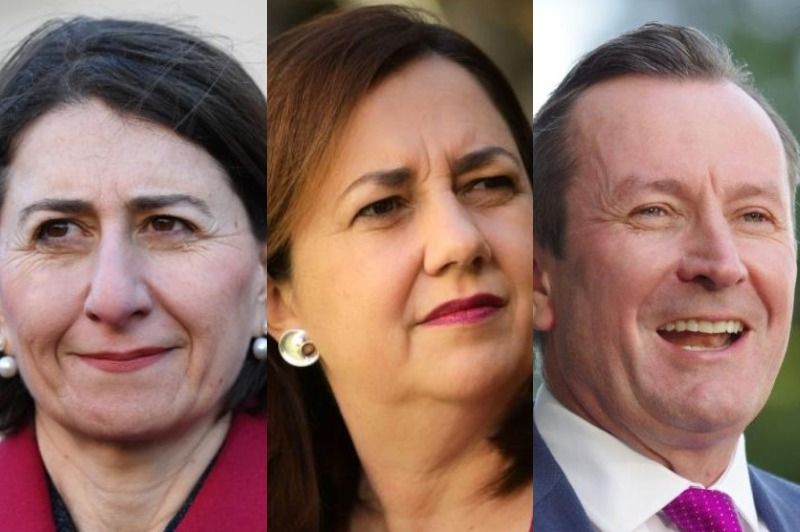
DITCH THE MIDDLE MAN – NO MORE STATES
Around the world, millions of people have been medically tested for COVID-19, and we have been tested in other ways as well. National economies, political leadership and individual resilience have also been tested. Additionally, the pandemic has tested the integration and coordination of Australia’s three-tier system of federal, state and local governments.
While Australia’s multi-level law-making structure looks like a neatly layered cake, there are hidden overlaps which cause blurred lines of separation. History shows that whenever there is a crisis or issue in Australia which transcends state borders, the inherent weaknesses of our governance structure are laid bare. The latest example of this is the novel coronavirus outbreak.
During the height of the pandemic, it was not possible to secure a nationally consistent approach to schooling. Federal and state governments expressed differing viewpoints, leaving parents confused. The PM was blindingly clear in wanting kids to continue attending classrooms. However, the states undermined him by encouraging parents to home school their children.
While education is a state government responsibility, helping Australians weather the economic consequences of the pandemic falls largely to the federal government. That’s why Scott Morrison asked premiers to keep schools open so that parents could continue to work and “put food on the table”.
With no clear chain of command on this issue, simmering tensions between the prime minister and state premiers were exposed. It was impossible for the PM to get the premiers to fall into line. Rebellious states – led by NSW Premier Gladys Berejiklian and Victorian Premier Daniel Andrews – rushed to introduce remote learning so that parents could keep their kids home.
The conflicting messages from the states and the federal government about whether it was safe to send kids to class was seized upon by the media which had a field day reporting the jostling for power. NSW, Victoria and the ACT broke ranks by making unilateral announcements about schooling arrangements which put them at odds with their federal counterparts.
Gladys Berejiklian was also involved in another political football match – the Ruby Princess fiasco. Australians were treated to the unedifying spectacle of political finger pointing over who was responsible for allowing the ill-fated ship to dock in Sydney and for passengers to disembark unchecked.
Authorities passed the buck with NSW officials claiming that they were given permission by the Australian Border Force (ABF) to let passengers off the ship. The ABF returned serve by laying the blame at the feet of NSW Health. A Special Commission of Inquiry is underway to establish which authority ultimately gave the green light to passenger disembarkation.
Another area where Australian governments were not on the same page was lockdown rules. The nationwide lockdown announced by the PM was, quite rightly, accompanied by a warning that police would charge citizens who flouted the rules. But the raft of restrictions on activities varied, depending on where you live.
Individual state and territory governments decided the specifics of the lockdown in their jurisdiction. Each introduced differing measures to restrict movement and this caused confusion among the populace regarding the do’s and don’ts of going outside. For example, Victoria closed golf courses while NSW left them open.
There was a crackdown by police around the nation on “non-essential travel”. Drivers were told that they were required to have a “reasonable excuse” for leaving home. It was clear that popping out to buy groceries and medical supplies constituted essential travel. However, other reasonable excuses for taking to the roads varied from state-to-state.
The legality of driving lessons turned out to be a hot-button issue. In Victoria, a hefty fine of $1,652 was issued to a 17-year-old learner driver as her driving lesson was classified as non-essential travel. The fine made headlines around Australia and, following public backlash, it was withdrawn.
NSW Police took to Facebook to assure citizens of New South Wales that driving lessons were regarded as a “reasonable excuse” to leave home. Police in Tasmania also stated that driving lessons were permitted. South Australian authorities similarly gave the green light to driving lessons provided that they were supervised by a household member.
We also had to contend with state border closures which left Australia’s federal model in strange territory. While the prime minister closed our national borders to foreign travellers, many premiers took the unprecedented step of shutting their domestic state borders to segregate themselves from the rest of the nation. The premier of WA, Mark McGowan, summed it up this way: “In effect, we’ll be turning Western Australia into an island within an island – our own country”.
Of course, Australian states and territories are not independent sovereign nations but part of a single Commonwealth of Australia. This view is supported by George Williams, the dean of law at the University of NSW who opined that there is a constructional issue in closing a state border.
We have section 92 of the Australian constitution and it says trade, commerce and intercourse amongst the States shall be absolutely free. The idea is that we are one country, and a person should be entitled to travel around Australia as they wish.
While closing state borders caused ructions, re-opening them has created even more political drama. NSW Premier, Gladys Berejiklian, claimed that those states keeping their borders closed were “hindering” the nation’s economic recovery. WA Premier, Mark McGowan, hit back saying that he would not be “bullied” by a state (NSW) which allowed the Ruby Princess disaster to unfold.
The Queensland Premier, Annastacia Palaszczuk, was more diplomatic in her response to NSW saying that Queensland would be “seeing southerners return to our glorious sunshine state” towards the end of the year.
It is instructive to note that there was never national advice issued by the federal government recommending that states should close their borders.
In many parts of the world, the catch-cry for coronavirus is “we’re all in this together”. Yet, when it comes to Australia, each state and territory stands somewhat alone. This is the result of parochial decision making at a state level and the power struggle between different levels of government.
I acknowledge that the political actors involved in this life and death drama have worked tirelessly to stop the spread of the pandemic and are to be thanked. While mistakes have been made, my biggest criticism is aimed squarely at the stage upon which Australia’s politicians had to perform – a three-tier system of government which pitted authorities against each other.
There has long been debate in Australia about whether to abolish the states. Former PM, Bob Hawke, is one of many prominent Australians to have called for a federation overhaul. The complex nature of contemporary issues facing Australia – like climate change and now a global pandemic – is beyond the current three-tier structure as there is no express head of power for “the environment” or “pandemics”.
The inconsistencies between the states have long frustrated me. I once worked for an organisation which spent over a decade lobbying government for uniform credit legislation throughout Australia. I watched with anticipation John Howard’s efforts to secure uniform gun legislation following the Port Arthur massacre. And I’ve listened to upwardly mobile Australian executives with children complain about the lack of uniformity in school curricula around the country.
Let’s be honest – the only reason we have three levels of government is due to the burden of history (or path dependency). Australia started out as six independent colonies. The joining of these colonies into a federation of six states to form the Commonwealth of Australia was a good idea in 1901. Today, I humbly submit that the federal/state structure of government has passed its use-by date.
The Founding Fathers of our great nation would not have envisaged the buck passing, endless bickering and unnecessary duplication that have come to characterise federal/state relations. Blaming Canberra first is the default modus operandi for the states and my sense is that many Australians are sick of politicians playing the blame game. No system of democracy is perfect – but surely, we can do better than what we currently have in place.
It’s time to scrap the states.
Regards
Paul J. Thomas
Chief Executive Officer
Ductus Consulting


Great try Paul but I don’t expect to see it in my time on Earth
A brilliant article, Paul and I couldn’t agree more. Interestingly, Sweden has a similar 3-level structure for governance. The national level, the regional level and the communal/municipal level. Sweden is divided into 21 regions and 290 communes. We share a common problem when it comes to governing the country. The division of power and responsibilities between the 3 levels is unclear and has been exposed like never before during the ongoing pandemic.
Lars